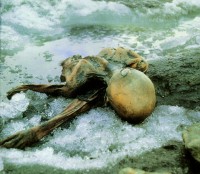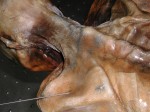 Oetzi the Iceman was discovered protruding from the ice of a glacier in the Oetzal Alps of the South Tyrol by hikers on September 19th, 1991, and in the years since has become the most studied mummy in the world. Kept in a climate controlled chamber with a viewing window for visitors at the South Tyrol Museum of Archaeology in Bolzano, Italy, Oetzi is under constant monitoring by researchers who use the latest and greatest technology to discover new information about his life and death with as little interference with the remains and artifacts as possible.
Oetzi the Iceman was discovered protruding from the ice of a glacier in the Oetzal Alps of the South Tyrol by hikers on September 19th, 1991, and in the years since has become the most studied mummy in the world. Kept in a climate controlled chamber with a viewing window for visitors at the South Tyrol Museum of Archaeology in Bolzano, Italy, Oetzi is under constant monitoring by researchers who use the latest and greatest technology to discover new information about his life and death with as little interference with the remains and artifacts as possible.
The question of what he ate in the day or days before someone shot an arrow in his back severing his subclavian artery — he bled to death within minutes — was previously addressed by analysis of the fecal material found in his bowels. They contained the remains of red deer meat and some kind of cereal eaten at least four hours before his murder. In 2011, microbiologists at the Institute for Mummies and the Iceman in Bolzano reexamined CT scans from 2005 and discovered something previous researchers had missed: Oetzi’s stomach. It had shifted north, which is why it was missed the first time, and it appeared to be full.
 A sample of the stomach contents contained animal fibers which DNA analysis identified as Alpine ibex meat. This was his last meal, ingested 30 to 120 minutes before he died. The meat of the Alpine ibex was traditionally believed to have medicinal properties, and since Oetzi suffered from chronic joint pain, Lyme disease, periodontal disease, ulcers and a panoply of non-fatal wounds including knife cuts and blunt force trauma to his teeth received in the days and hours before his death, he had more than enough reasons to seek out healing foods.
A sample of the stomach contents contained animal fibers which DNA analysis identified as Alpine ibex meat. This was his last meal, ingested 30 to 120 minutes before he died. The meat of the Alpine ibex was traditionally believed to have medicinal properties, and since Oetzi suffered from chronic joint pain, Lyme disease, periodontal disease, ulcers and a panoply of non-fatal wounds including knife cuts and blunt force trauma to his teeth received in the days and hours before his death, he had more than enough reasons to seek out healing foods.
New research has been able to narrow down how the Ibex meat was prepared.
Mummy specialist Albert Zink from the European Academy of Bolzano said he was able to analyse the nanostructure of meat fibres from a mountain goat found in Ötzi’s stomach – indicating that the meat was raw and had been dry-cured, and not cooked or grilled, which would have weakened the fibres.
He added that Ötzi did not have a proper hunting bow with him, and probably carried the dried meat with him from his home, as raw meat would have quickly gone bad.
Further analysis of his stomach contents showed that he had not eaten cheese or dairy products, just meat. “It seems probable that his last meal was very fatty, dried meat – perhaps a type of Stone Age Speck or bacon,” Zink said. As Ötzi had hiked down from the South Tyrolean side of the Alps, it’s likely his provisions came from there.
Speck is a famous local delicacy in the Tyrol. Cured with salt and spices and cold-smoked, Tyrolean Speck goes back to the 13th century. Little did we know that it was being made from wild mountain goats in the area 4,000 years before it was made from the hind legs of pigs. I’m not sure how fatty ibex meat can possibly be, though. These animals are accustomed to scrambling up and down the Alps, after all, not chilling in a wallow.
For the makers of Tyrolean Speck this is indeed great news. It also seems to indicate that Otzi seems to have been up there on an almost regular basis (cf. his alpine equipment and his indeed unready arrows and hunting bow).
Unfortunately, I have not tasted ibex speck so far, but their smoked wild boar sausages are nothing but sensational. Moreover, to smoke or otherwise ‘cure’ meat over the winter is probably a procedure done there forever, and even domesticated pigs were not completely unheard of back then.
The man himself was also treated like a hunted animal. His body obviously received a blow to the head and was turned over, obviously in an attempt to rescue the flint arrow head, hence his rather strange arm posture frozen in time, while lying on his stomach.
:hattip:
From WKPD
“It is possible that Ötzi’s death may have been recorded on an ancient stone stela. The decorated stone, of roughly the same age as the Ice Man, had been used to build the altar of a church in Latsch, a town close to the area where the discovery of Ötzi was made. One of the carvings shows an archer being poised to fire an arrow towards the back of an unarmed man who is running away.”
Can this be a leg-pull?
Is ibex “very fatty”? If not, might we closer to bresaola than speck (which I think needs to come from a pig)?
This scenario is the most plausible, and after 25 years, Otzi still continues to fascinate us.
Ed, the matter is indeed about Bresaola and in particular ‘Bundnerfleisch’ (the Swiss version, not fatty at all), what it is, why pepper plays a very important role, what the World Trade Organization has got to to with it and under which terms of customs the whole thing should further be discussed. Also, a ‘piquant inquiry‘ is later announced:
The former Swiss minister of Finance and President of the Confederation reading a rather elaborate prepared statement in Parliament. Apparently, that statement was prepared by one of his subordinates and he is getting a fit of laughter about it at 2:00.
In Italy, the biggest food-fights with Brussels involve “lardo di Colonnata” (extremely fatty bacon aged in marble containers)and “pecorino di fossa” (sheep cheese aged in ancient sewers or tombs)–all of which is strictly forbidden but still available. It’s a pity that Ötzi didn’t have Ibex cheese in his stomach as well!
All these centuries later & it’s not like I knew the guy, but yet I still feel bad for Oetzi :no: